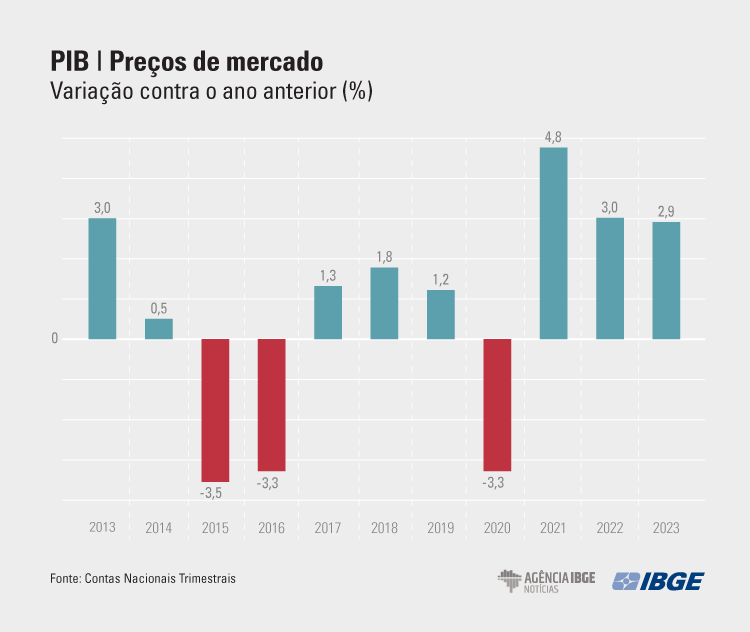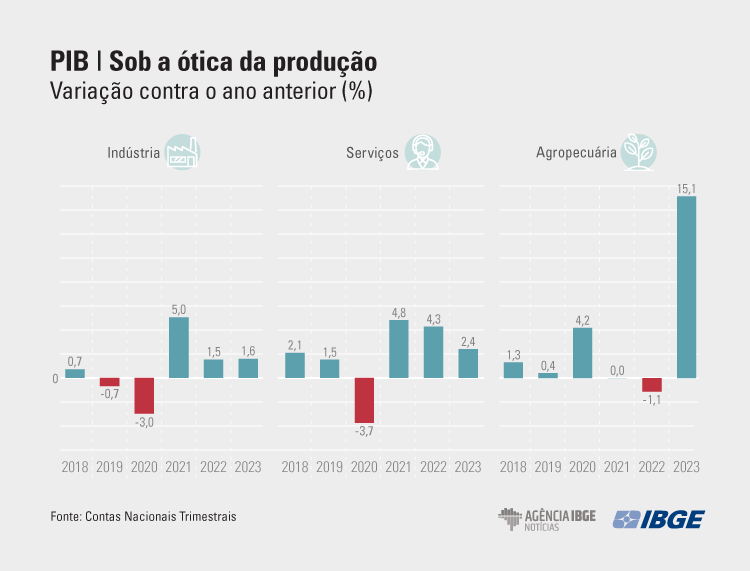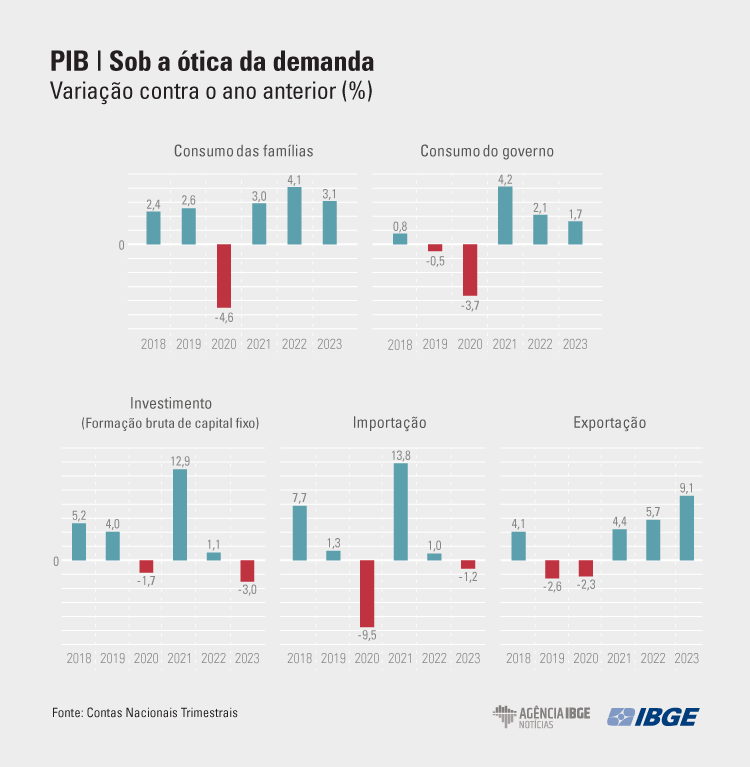National Accounts
With a record rise in Agriculture, GDP closes 2023 at 2.9%
March 01, 2024 09h00 AM | Last Updated: March 04, 2024 11h09 AM

The Brazilian Gross Domestic Product (GDP) remained stable in the fourth quarter of 2023 and closed the year with a growth of 2.9%, adding up to R$10.9 trillion. The agricultural activity grew 15.1% between 2022 and 2023, influencing the performance of the Brazilian GDP. Industry (1.6%) and Services (2.4%) grew as well. The per capita GDP reached R$50,194, an advance in real terms of 2.2% in relation to 2022. The data are from the System of Quarterly National Accounts, released today (1) by the IBGE.

Rebeca Palis, IBGE´s Coordinator of National Accounts, explains that the record result in Agriculture, surpassing the drop shown in 2022, was influenced by the growth in the output and by the productivity gain in Agriculture. “This behavior was leveraged by the growth in soybeans and corn, two of the most important crops in Brazil, which had their record output registered by the Systematic Survey of Agricultural Production (LSPA),” stands her.
Another positive influence on the result of the GDP in 2023 was the performance of Mining and quarrying industries. That activity rose 8.7% due to the increase in the petroleum and natural gas extraction and iron ore. Having risen 6.5%, Electricity and gas, water, sewage, activities of waste management stood out as well. “Hydric conditions were favorable and the green tariff flag remained in force during the entire year. In addition, climate phenomenon El Niño increased the average temperature, impacting on the consumption of water and energy,” justifies the researcher. Manufacturing industries (-1.3%) and Construction (-0.5%) closed the year down.
In Services, all the activities grew, highlighted by Financial activities, insurance and related services (6.6%). “Insurance companies recorded a gain by comparing insurance premiums received with claims paid,” explains Palis.

Consumption of households is the biggest influence on the GDP under the point of view of demand
Under the point of view of demand, Household consumption expenditure, which advanced 3.1% in relation to 2022, stood out The researcher explains that the result was influenced by the improvement in the conditions of the labor market, like the increase of jobs and of the real wage bill, as well as by the cooling of inflation. “Governmental cash transfer programs significantly helped to grow the household consumption, especially in food and non-durable essential products,” completes Palis.

Still under the point of view of demand, Gross fixed capital formation fell 3.0%, highlighted by the drop in machinery and equipment (-9.4%). On the other hand, Government consumption grew 1.7% in the year.
Imports of goods and services dropped 1.2% in 2023, whereas Exports grew 9.1%. “Here we notice the influence of the growth in the output of corn and soybeans and of the extraction of petroleum and iron ore, important commodities in Brazil,” describes Palis. The investment rate in 2023 was 16.5% of the GDP, lower than in 2022. On its turn, the savings rate stayed at 15.4% in 2023 against 15.8% in the previous year.
Of the total current value of R$10.9 trillion of the GDP, R$9.5 trillion were related to Value added at basic prices, whereas R$1.4 trillion were related to Product taxes net of subsidies.
GDP of Q4 2023 remains stable compared with Q3
The GDP remained stable (0.0%) in the comparison between the fourth and third quarters of 2023. Among the sectors, Industry grew 1.3%, whereas Services changed 0.3%. With relevant harvests concentrated in the first semester, Agriculture retreated 5.3%. In the industrial activities, the rise in Mining and quarrying industries (4.7%), Construction (4.2%) and Electricity and gas, water, sewerage and waste management (2.8%) stood out. On the other hand, Manufacturing industries registered a negative change (-0.2%).
In Services, the groups of Other services activities (1.2%), Financial activities, insurance and related services (0.7%), Real estate activities (0.1%) and Administration, defense, public health and education, and social security (0.1%) recorded positive rates. In contrast, Trade (-0.8%), Transportation, storage and mailing (-0.6%) and Information and communication (-0.1%) dropped.
Under the point of view of demand, Gross fixed capital formation and Government consumption expenditure grew (both with 0.9%), whereas Household consumption expenditure (-0.2%) reported a negative change.
Concerning the foreign sector, Exports of goods and services remained virtually stable (0.1%), whereas Imports of goods and services rose 0.9% in this comparison.
More about the survey
The System of National Accounts shows, on a quarterly basis, the current values and the volume indexes for the Gross Domestic Product (GDP) at market prices, taxes on products, value added at basic prices, personal consumption, government consumption, gross fixed capital formation, stock changes, and exports and imports of goods and services. The survey began in 1988 at the IBGE and it was redesigned in 1998, when its results were integrated to the System of National Accounts, which has an annual periodicity. Please check the GDP data on Sidra. The next release, related to the first quarter of 2024, will be on June 4.



















